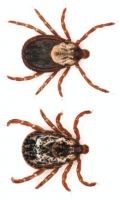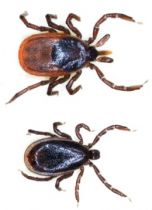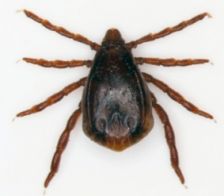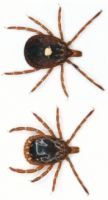Ticks
 Description: This is a colorful species, having spots of light colors (white, gray, silver) scattered and superimposed over the basic brown or black body color.
Description: This is a colorful species, having spots of light colors (white, gray, silver) scattered and superimposed over the basic brown or black body color.Life Cycle: Under suitable conditions the life cycle from egg to adult may require only 3 months but usually takes over a year to complete.
Black-legged or Deer Tick
 Description: Body with tear-drop shape and relatively small size. Dorsal sheild is blackish while the body behind it is reddish-brown which fades to grey on engorged specimens.
Description: Body with tear-drop shape and relatively small size. Dorsal sheild is blackish while the body behind it is reddish-brown which fades to grey on engorged specimens.
Habitat: A pest of livestock and wildlife. During early fall it is often the most common tick on deer and cattle. May be found along paths, trails, and roadways. Lyme disease, caused by a spirochetal bacterium Borrelia burgdorferi, may be transmitted by the bite of Ixodes scapularis.
Life Cycle: Adults become active in late September and October and are present until March or April. The preferred host for larvae and nymphs is the white-footed mouse, while adult ticks prefer to feed on white-tailed deer. Ticks can feed on humans at any stage, but most often the nymph transmits the spirochete. Animal studies have shown that Ixodes ticks must remain attached for at least 24 hours in order to transmit B. burgdorferi.
Brown Dog Tick
 Description: The mature, blood-engorged female is gray and will swell to the size of a small raisin.
Description: The mature, blood-engorged female is gray and will swell to the size of a small raisin.
Habitat: The brown dog tick infests homes and other buildings harboring dogs. These ticks have a strong tendency to crawl upward and may be found behind moldings at the top of walls or hidden in cracks and crevices in the ceiling. They may also be found behind curtains, in furniture, and under rugs.
Life Cycle: All stages develop readily on dogs, no intermediate hosts are required. Under favorable conditions the entire life cycle can be completed in less than two months. Eggs are deposited in cracks and crevices of the kennels or other quarters frequented by the dog. The eggs generally hatch in 20 to 30 days or longer, depending upon temperature. The adult ticks are most often found in the ears and between the toes of dogs, and the larvae and nymphs in the long hair at the back of the neck.
Lone Star Tick
 Description: This tick is about 1/8 inch long and is dark brown. The tick receives its name from the lone white spot on the dorsal shield of the female. The male has nonconnected white markings around its posterior margin. Mouthparts are long compared to most other ticks.
Description: This tick is about 1/8 inch long and is dark brown. The tick receives its name from the lone white spot on the dorsal shield of the female. The male has nonconnected white markings around its posterior margin. Mouthparts are long compared to most other ticks.
Habitat: A pest of livestock and wildlife. All life stages readily attack humans. This is probably the tick most often encountered by people during recreational activities in Oklahoma. Ticks will await a host along trails and pathways. This tick is known to transmit Rocky Mountain spotted fever, Human Ehrlichiosis, Tularemia, and American Q fever.
Life Cycle: Active from early spring to late fall. The females is capable of laying 9-12,000 eggs.